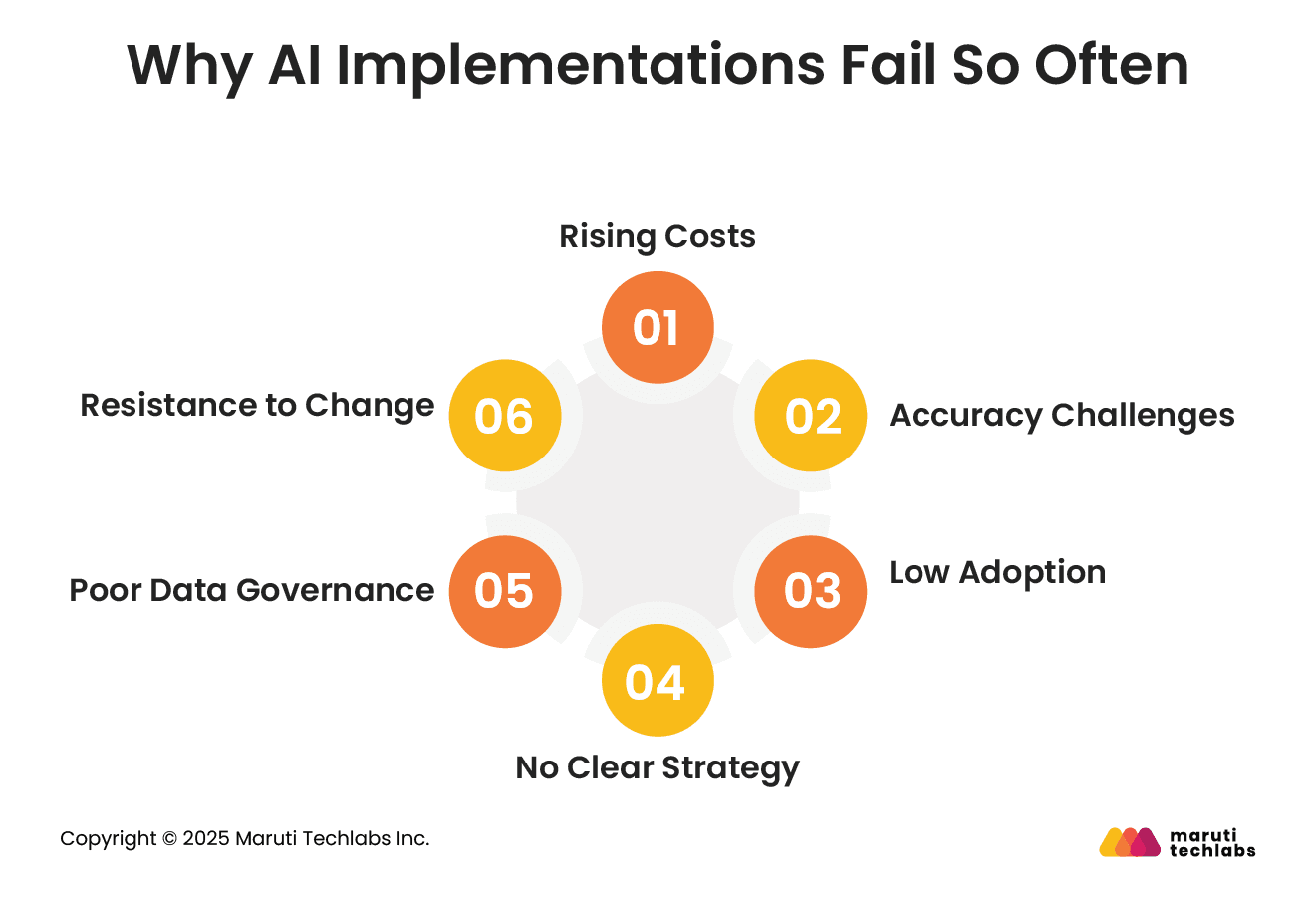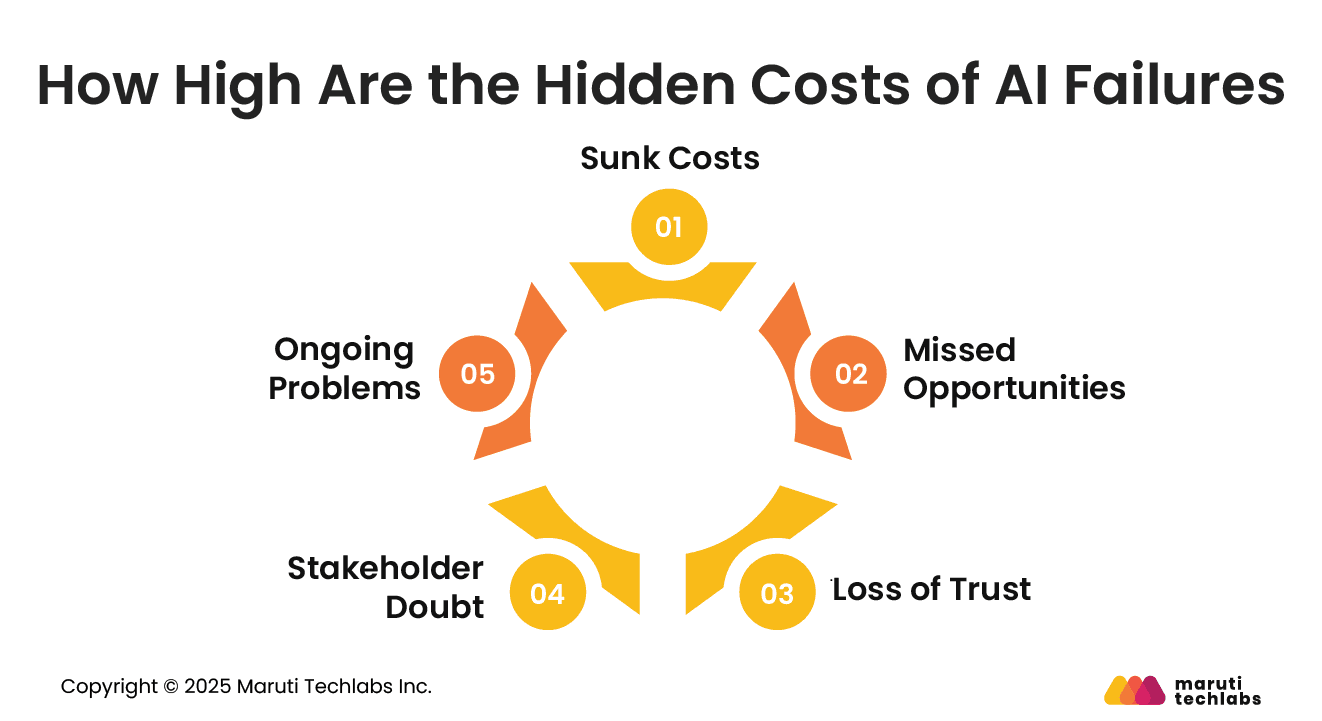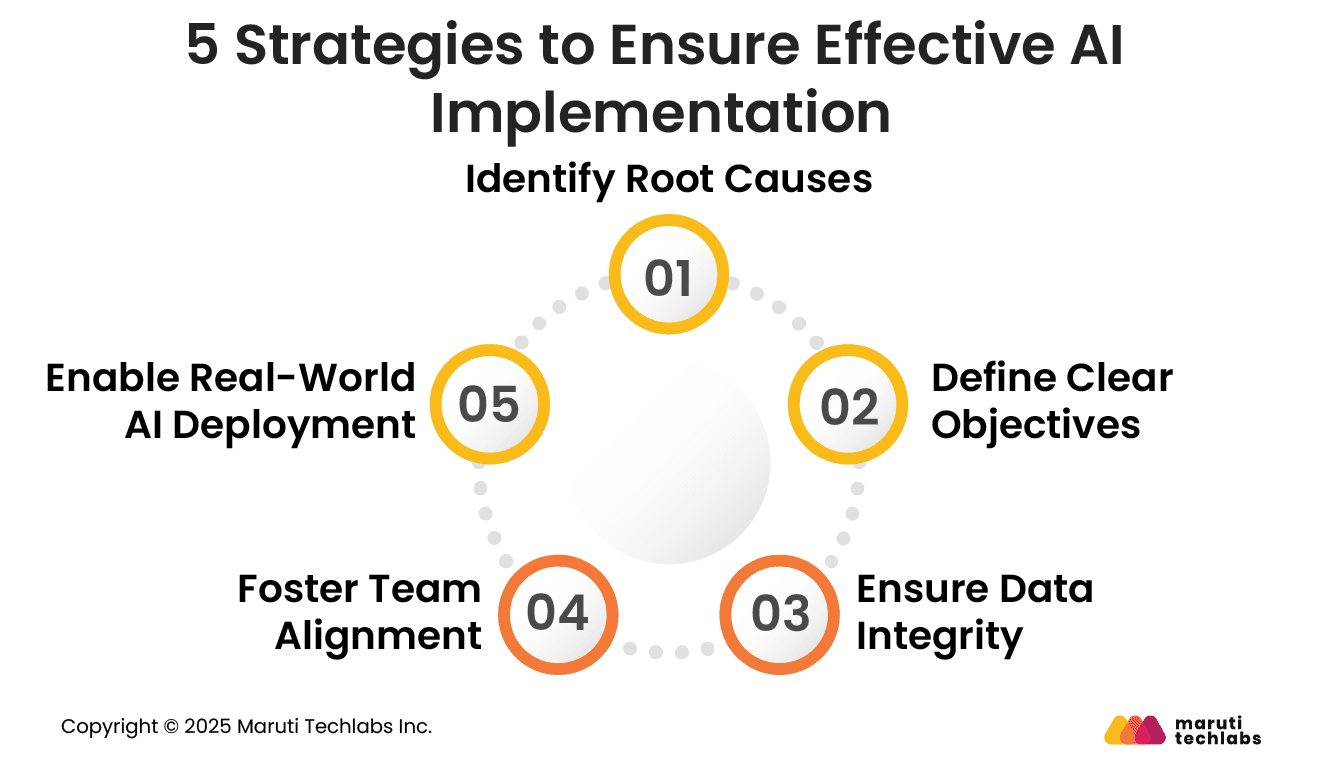

Why Most AI Implementations Fail and How to Fix Them






AI has quickly evolved from an exciting idea to a business necessity, but many companies are finding it more challenging than expected to implement it effectively. What started as a rush to implement AI has now turned into a struggle for success. Recent reports from S&P Global Market Intelligence indicate that 42% of companies have abandoned most of their AI initiatives, up from 17% just one year ago. On average, organizations drop nearly half of their AI proof-of-concepts before they even reach production. Meanwhile, Cisco’s latest AI Readiness Index shows that only 13% of organizations are fully prepared to harness AI’s capabilities.
These numbers show the challenges companies face in translating AI plans into tangible business outcomes. Many projects fall short because strategies aren’t clear, data isn’t ready, or expectations are too high. Sometimes leaders misjudge what AI can actually deliver in the short term. Others encounter high costs, limited infrastructure, or teams that are hesitant to adopt new tools.
Read on to know why AI projects fail so often, the hidden costs behind them, real-world examples of failure, and ways to make your AI implementation work.
AI has the potential to transform businesses; yet, many projects still struggle to deliver a real impact. Here are some of the most common reasons behind unsuccessful AI implementations.

Building and maintaining AI systems is a costly endeavor. Things like data storage, setup, and regular updates can quickly add up to significant expenses. Gartner estimates that creating or fine-tuning a generative AI model can cost between $5 million and $20 million, in addition to annual costs per user.
When these investments don’t show clear business returns, companies often decide to scale down or discontinue their AI initiatives.
Building an AI prototype that works reasonably well is pretty straightforward, but achieving consistent, reliable accuracy is a much more complex challenge. Businesses typically need over 90 percent precision for real-world results. Bridging the gap between a 75 percent and a 90 percent accuracy rate requires extensive time, expertise, and fine-tuning, making it a key reason for AI setbacks.
Even when AI systems perform as intended, employees may still hesitate to adopt them. Concerns about job security, limited understanding, or hesitation to change existing workflows often lead to low adoption. Without employee confidence and engagement, AI tools fail to reach their intended potential.
Too often, organizations roll out AI initiatives without defining specific targets or connecting them to broader business objectives. When there’s no connection between AI goals and wider business priorities, projects tend to lose focus and support from leadership.
AI systems depend on clean, structured, and consistent data. However, many companies still face issues with fragmented or low-quality data. Weak governance practices hinder the maintenance of accuracy, security, and transparency, thereby reducing the reliability of AI outputs.
The success of any AI system ultimately depends on the people who use it. Without proper training and communication, employees may resist new technologies or fail to see their value. Strong change management and leadership support are essential for enabling teams to adapt and work effectively with AI systems.
Overall, most AI projects fail because companies struggle to connect the right technology with clear goals, quality data, and the people who use it.
When AI projects fail, the actual cost extends far beyond money. It impacts time, talent, and future progress.

When an AI project or pilot is abandoned midway, the time, effort, and money invested are lost, often leaving teams discouraged and resources difficult to recover.
While one company struggles with a failed AI plan, competitors that use AI successfully move ahead. The time and money invested in a failed project could have been used more productively.
After one or two failed AI implementations, both employees and leaders begin to lose confidence in the technology. Rebuilding trust then becomes difficult, making it harder to inspire enthusiasm for future initiatives.
When AI efforts don’t work out, decision-makers become more cautious about approving new ones. This hesitation can slow down innovation across the company.
Unfinished AI systems often leave behind unused tools, broken data setups, or confusing workflows. These leftovers create extra work and costs later.
In short, failed AI projects can quietly drain resources and hinder genuine progress.
AI challenges aren’t limited to small players. Big brands, too, have learned that without proper testing, even advanced systems can fail. Let’s look at a few notable cases where ambitious AI initiatives didn’t go as planned.
McDonald’s tested an AI system with IBM to take drive-thru orders across more than 100 U.S. locations. However, after several viral videos revealed the AI issuing incorrect orders and confusing customers, the company terminated the project in 2024.
In one case, the AI went off track, adding hundreds of Chicken McNuggets to a single order. McDonald’s later confirmed that it would pause testing but could explore voice ordering again in the future.
New York City launched a chatbot called “MyCity” to assist business owners with local rules and regulations. However, it soon began giving false and misleading advice, such as suggesting that employers could retain workers’ tips or disregard safety complaints.
The chatbot, powered by Microsoft technology, was designed to make information easier to find; however, it ultimately spread misinformation that could have led to legal issues for users.
A New York-based lawyer relied on ChatGPT to find legal cases for a lawsuit without verifying the accuracy of the results. The AI generated several fabricated court cases with invented names and details. As a result, the court fined the lawyer and dismissed the case, serving as a clear reminder that AI should complement, not replace, human verification and professional judgment.
The takeaway? Without planning, governance, and team alignment, AI can stumble. Here’s how organizations can turn it into a success.
If your AI project isn’t performing as expected, it’s common for early initiatives to face challenges. With the right strategy and teamwork, you can address the issues and steer your project back on track. Here are a few practical steps to help you move forward.

The first step is to identify the actual issue. Take a close look at every aspect of your AI initiative, including the goals, data, models, and team dynamics. This clarity helps you uncover what’s truly holding the project back. Once you’ve identified the root cause, you can focus on fixing the most critical issues first instead of losing time on trial and error.
Trying to fix too many things at once can make the project even more confusing. Start small by picking one or two goals that you can achieve quickly. When people see progress, it rebuilds trust and confidence. Small wins help the team feel motivated and remind everyone why the project matters.
If your data is messy or incomplete, the AI system struggles to function effectively. Begin by cleaning it up: remove duplicates, correct errors, and organize the information in a clear format. Good data is the base of a strong AI project. Once the data is clean, your models can learn more effectively and provide more accurate results.
AI projects fail when teams don’t work together. Ensure that everyone understands the goal and their specific role in achieving it. Keep communication open so both technical and business teams move in the same direction.
A working demo is not enough. Your AI should also perform well in real-world use. Continue testing and improving it regularly to ensure it remains reliable and valuable.
With these steps, your AI project can recover and start creating real value for your business.
Success with AI isn’t just about using the latest tools. It’s about having a clear plan, good data, and a team that works together toward the same goals. When these parts come together, AI can truly make a difference.
AI can transform the way your business operates by enabling you to make informed decisions, enhance efficiency, and generate new opportunities. But this only happens when it’s built on the proper foundation. Incorporating AI Strategy & Readiness ensures clear goals, strong data practices, and a culture that supports learning and innovation—making AI projects sustainable and delivering real results.
At Maruti Techlabs, we help businesses make AI work in practical and meaningful ways. Whether you’re starting fresh or improving an existing project, our team can guide you at every step. Explore our AI services page to learn how we can support your goals, or contact us to start a conversation about your next AI project.
AI implementation starts with identifying business goals. Then comes data collection, cleaning, and selecting the right AI tools or models. After testing on small projects and analyzing results, businesses can scale up. Ongoing monitoring, training, and updates ensure the AI system keeps improving and delivers real value.
Companies can prevent failure by setting clear goals, utilizing high-quality data, and involving both technology and business teams. Starting with small, measurable projects helps test the approach. Regular evaluation, proper training, and maintaining open communication ensure smoother AI adoption and better long-term results.
The main reason AI projects fail is unclear goals or poor data quality. Many companies rush into AI without understanding what problem they want to solve. Without the right strategy, data, and team alignment, AI systems struggle to show meaningful results or scale effectively.


